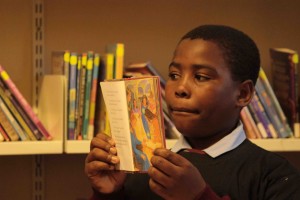 Reading aloud is an important aspect of children’s literacy learning:
Reading aloud is an important aspect of children’s literacy learning:
- They become hooked on stories and appreciate the power of print.
- It helps them to understand what books are for and how print works.
- They learn about the meanings and messages in a story.You can read stories and other texts to children that they wouldn’t necessarily want to or be able to read for themselves, but that they can engage with by listening and discussing. This gives them access to complex ideas and language and stretches their thinking and imagination.
- They deepen their ability to predict (guess) what will happen next, sharpening their thinking skills, problem solving ability and creativity.
- They extend their knowledge and understandings when they make connections between what happens in stories and their own lives.
- They get to know the ‘tune’ or rhythm of different texts so that when they read for themselves, familiarity with story language aids meaning making.
Before reading to a group:
- Read through any picture book yourself before you read it to the children. If it’s a novel or chapter book, and you haven’t read it, skim through it so that you are familiar with the characters, plot and themes of the book before you read it aloud to others.
- Make sure that the children are seated comfortably in front of you and will be able to see the pictures in the book.
- If you need to, sing a song or say a rhyme together to capture their attention and to help the children settle down.
- If you’re reading a new story, show and read the front and back cover, and discuss a little about what the story is going to be about before you start reading.
During group reading:
- With a picture book, it’s often good to read the whole story without interruption once or twice. However, this is not a rule so if the children seem restless, or want to comment, stop and have a discussion or listen to what they want to say, and then carry on reading.
- Read it again, stopping to talk about what is happening in the picture/s. Pictures help to tell a story and sometimes tell more than the words do. Beginner readers often talk their way through a story using the pictures. They may know the story by heart or use their own words. This is not ‘cheating’, but part of beginning to read. When children are starting to read for themselves, pictures help them make good guesses about words they do not know yet.
- When children ask questions or make comments, it is a sign that they are interested. Help by asking open-ended questions like: ‘Why do you think she did that?’, ‘What do you think is going to happen next?’, ‘What would you do if it was you?’.
- Even when children cannot read for themselves, encourage them to join in right from the start by humming along with a rhyme or song, finishing a phrase or repeating what you have read. As the children get to know a story or verse, they will begin to remember it, and join in more, especially with repeated phrases.
After reading to a group:
- Now move on to other activities. Do not use all the ideas below with each story. Rather choose one or two of them and cover them briefly.
- Let the children explore and think about the story by drawing their own picture about an aspect of what you have read.
- Talk about the book. Talking about stories adds to enjoyment and understanding. It helps children to get involved in stories and to feel like readers. Here are some questions to ask:
- Recall: What was it about? Who was in it? What happened to X or Y? What made X or Y decide to do Z?
- Retell: Who wants to tell the story? What happened first? What next? How did it end?
- Reflect: Who did you like most? Why? If you were [character’s name] what would you have done? Which part of the story is your favourite? Did you like the ending? If you could choose, how would you have ended the story?
- Children become confident when they know stories well. Re-reading old favourites is emotionally satisfying so don’t worry if you are asked to read the same story over and over. Allow the children to do so as well, alone or in pairs or groups.
- Many children enjoy acting out stories. They can retell the story in their own words, or use the exact words from the story. Through acting out the story, they enjoy themselves and extend their thinking and learn empathy by exploring different points of view, like those of the villain or the hero. They also learn to work together and co-operate and gain confidence as storytellers. All of this will help them with their own story writing, too.

